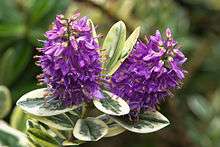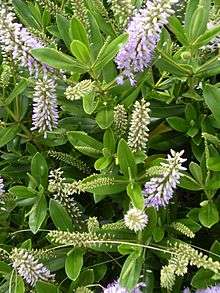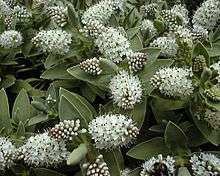Hebe (plant)
Hebe /ˈhiːbiː/[1] is a genus of plants native to New Zealand, Rapa in French Polynesia, the Falkland Islands, and South America. It includes about 90 species and is the largest plant genus in New Zealand. Apart from H. rapensis (endemic to Rapa), all species occur in New Zealand. This includes the two species, H. salicifolia and H. elliptica, that have distributions extending to South America. The genus is named after the Greek goddess of youth, Hebe.
| Hebe | |
|---|---|
 | |
| Hebe 'Waireka' | |
| Scientific classification | |
| Kingdom: | Plantae |
| Clade: | Tracheophytes |
| Clade: | Angiosperms |
| Clade: | Eudicots |
| Clade: | Asterids |
| Order: | Lamiales |
| Family: | Plantaginaceae |
| Tribe: | Veroniceae |
| Genus: | Hebe Comm. ex Juss. |
| Species | |
|
See text | |
There are differing classifications for the genus and some botanists now include Hebe, together with the related Australasian genera Chionohebe, Derwentia, Detzneria, Parahebe, Heliohebe and Leonohebe, in the larger genus Veronica (hence its common name shrubby veronica).[2][3][4]
Hebe has four perpendicular rows of leaves in opposite decussate pairs. The flowers are perfect, the corolla usually has four slightly unequal lobes, the flower has two stamens and a long style. Flowers are arranged in a spiked inflorescence. Identification of Hebe species is difficult, especially if they are not in flower. The plants range in size from dwarf shrubs to small trees up to 7 metres, and are distributed from coastal to alpine ecosystems. Large-leaved species are normally found on the coast, in lowland scrub and along forest margins. At higher altitudes smaller-leaved species grow, and in alpine areas there are whipcord species with leaves reduced to thick scales.
Hebes are grown in many gardens and public areas; they attract butterflies. Hebes cope with most soil types, and can be propagated easily from both seed and cuttings. Wild Hebe hybrids are uncommon; however, there are many cultivated hybrids, such as Hebe × franciscana.
The Hebe Society, formed in 1985 under the auspices of the Royal Horticultural Society, promotes the cultivation and conservation of hebes and other New Zealand native plants.
Species

About 90-100 species, including:
- Hebe acutiflora
- Hebe albicans
- Hebe amplexicaulis
- Hebe arganthera[5]
- Hebe armstrongii
- Hebe barkeri
- Hebe bishopiana
- Hebe brachysiphon
- Hebe breviracemosa
- Hebe brevifolia
- Hebe buchananii
- Hebe canterburiensis
- Hebe carnosula
- Hebe chathamica
- Hebe cheesmannii
- Hebe ciliolata
- Hebe colensoi
- Hebe cupressoides
- Hebe decumbens
- Hebe dieffenbachii
- Hebe diosmifolia
- Hebe elliptica
- Hebe epacridea
- Hebe gibbsii
- Hebe glaucophylla
- Hebe gracillima
- Hebe haastii
- Hebe hectorii
- Hebe hulkeana
- Hebe lavaudiana
- Hebe leiophylla
- Hebe ligustrifolia
- Hebe lycopodioides
- Hebe macrantha
- Hebe matthewsii
- Hebe obtusata
- Hebe ochracea
- Hebe odora
- Hebe parviflora
- Hebe pauciramosa
- Hebe pimeleoides
- Hebe pinguifolia
- Hebe propinqua
- Hebe rakaiensis
- Hebe raoulii
- Hebe recurva
- Hebe salicifolia
- Hebe salicornioides
- Hebe speciosa
- Hebe stricta
- Hebe subalpina
- Hebe subsimilis
- Hebe tetragona
- Hebe tetrasticha
- Hebe topiaria
- Hebe traversii
- Hebe trisepala
- Hebe venustula
- Hebe vernicosa
Cultivation
Hebes are valued in gardens in temperate climates as evergreen shrubs with decorative (sometimes variegated) leaves. The flowers, in shades of blue, purple, pink or white, appear throughout summer and autumn. Their ability to withstand salt-laden winds makes them especially suited to coastal areas, for instance the South West of England, where they are often grown as hedges. Prostrate varieties can be used as groundcover.[6][7] The following cultivars have gained the Royal Horticultural Society's Award of Garden Merit:[8]
- H. albicans[9] (white,1m)
- 'Blue Clouds'[10] (pale blue,1m)
- ’Caledonia’[11] (violet,1m)
- 'Emerald Gem'[12] (white, 0.3m)
- 'Great Orme'[13] (pink/white, 1.2m)
- H. macrantha [14]
- 'Margret' [15] (light blue, 0.5m)
- 'Midsummer beauty'[16] (lilac/white, 2.5m)
- 'Mrs Winder'[17] (violet-blue, 1m)
- 'Neil's Choice'[18] (violet, 1.2m)
- 'Nicola's Blush'[19] (pink/white, 1m)
- H. ochracea 'James Stirling'[20] (white, 0.5m)
- 'Oratia Beauty'[21] (pink/white, 0.75m)
- 'Pascal'[22] (violet-blue, 0.5m)
- 'Pewter Dome'[23] (white, 05m)
- H. pimeloides 'Quicksilver'[24] (pale violet, 0.5m)
- H. pinguifolia 'Pagei'[25] (white, 0.3m)
- 'Pink Elephant' [26] (white, 0.5m)
- H. rakaiensis[27] (white, 1m)
- H. recurva 'Boughton Silver'[28] (white, 1m)
- 'Red Edge'[29] (mauve/white, 0.5m)
- 'Sapphire'[30] (mauve, 1.5m)
- 'Silver Queen'[31] (mauve, 1m)
- H. topiaria[32] (white, 0.5m)
- H. vernicosa[33] (white, 0.5m)
- ’Wingletye’[34] (mauve, 0.5m)
- 'Wiri Dawn'[35] (pale pink, 0.5m)
- 'Youngii'[36] (violet/white, 0.2m)
Gallery
 Hebe speciosa
Hebe speciosa Hebe pinguifolia
Hebe pinguifolia Hebe buchananii
Hebe buchananii
 Hebe decumbens
Hebe decumbens Flowers of Hebe × franciscana
Flowers of Hebe × franciscana Flowers of Hebe × franciscana
Flowers of Hebe × franciscana Hebe x franciscana (Blue Gem)
Hebe x franciscana (Blue Gem)
 Hebe albicans
Hebe albicans Hebe rakaiensis
Hebe rakaiensis.jpg) Hebe stricta
Hebe stricta
References
- Sunset Western Garden Book, 1995:606–607
- Thompson, Ken (20 Jan 2011). "Don't judge a plant by appearances". The Telegraph. Retrieved 27 July 2017.
- "Hebe or Veronica". Our Changing World. Radio New Zealand. Retrieved 27 July 2017.
- Garnock-Jones, Philip; Albach, Dirk; Briggs, Barbara. "Botanical names in Southern Hemisphere Veronica (Plantaginaceae): sect. Detzneria, sect. Hebe, and sect. Labiatoides". Taxon. 56: 571–582.
- Garnock-Jones, Bayly, Lee, Rance (2000). "Hebe arganthera (Scrophulariaceae), a new species from calcareous outcrops in Fiordland, New Zealand". New Zealand Journal of Botany. 38: 379–388. doi:10.1080/0028825x.2000.9512690.CS1 maint: multiple names: authors list (link)
- Wheeler, Chris & Valerie (2002). Gardening with hebes. United Kingdom: Guild of Master Craftsmen. p. 160. ISBN 1861082916.
- Brickell, Christopher (2010). The RHS encyclopedia of plants & flowers. United Kingdom: Dorling Kindersley. p. 744. ISBN 1405354232.
- "AGM Plants - Ornamental" (PDF). Royal Horticultural Society. July 2017. p. 43. Retrieved 3 March 2018.
- "RHS Plant Selector - Hebe albicans". Retrieved 22 July 2020.
- "RHS Plant Selector - Hebe 'Blue Clouds'". Retrieved 5 July 2020.
- "RHS Plantfinder - Hebe 'Caledonia'". Retrieved 22 July 2020.
- "RHS Plant Selector - Hebe 'Emerald Gem'". Retrieved 5 July 2020.
- "RHS Plant Selector - Hebe 'Great Orme'". Retrieved 5 July 2020.
- "Hebe macrantha". RHS. Retrieved 27 July 2020.
- "Hebe 'Margret'". RHS. Retrieved 22 July 2020.
- "RHS Plant Selector - Hebe 'Midsummer Beauty'". Retrieved 5 July 2020.
- "RHS Plant Selector - Hebe 'Mrs Winder'". Retrieved 5 July 2020.
- "RHS Plant Selector - Hebe 'Neil's Choice'". Retrieved 5 July 2020.
- "RHS Plant Selector - Hebe 'Nicola's Blush'". Retrieved 5 July 2020.
- "RHS Plant Selector - Hebe ochracea 'James Stirling'". Retrieved 5 July 2020.
- "RHS Plant Selector - Hebe 'Oratia Beauty'". Retrieved 5 July 2020.
- "RHS Plant Selector - Hebe 'Pascal'". Retrieved 5 July 2020.
- "RHS Plant Selector - Hebe 'Pewter Dome'". Retrieved 5 July 2020.
- "RHS Plant Selector - Hebe pimeloides 'Quicksilver'". Retrieved 5 July 2020.
- "RHS Plant Selector - Hebe pinguifolia 'Pagei'". Retrieved 5 July 2020.
- "Hebe 'Pink Eplephant'". RHS. Retrieved 22 July 2020.
- "RHS Plant Selector - Hebe rakaiensis". Retrieved 5 July 2020.
- "RHS Plant Selector - Hebe recurva 'Boughton Silver'". Retrieved 5 July 2020.
- "RHS Plant Selector - Hebe 'Red Edge'". Retrieved 5 July 2020.
- "RHS Plant Selector - Hebe 'Sapphire'". Retrieved 5 July 2020.
- "RHS Plant Selector - Hebe 'Silver Queen'". Retrieved 5 July 2020.
- "RHS Plant Selector - Hebe topiaria". Retrieved 5 July 2020.
- "RHS Plant Selector - Hebe vernicosa". Retrieved 5 July 2020.
- "RHS Plantfinder - Hebe 'Wingletye'". Retrieved 2 March 2018.
- "RHS Plant Selector - Hebe 'Wiri Dawn'". Retrieved 5 July 2020.
- "RHS Plant Selector - Hebe 'Youngii'". Retrieved 5 July 2020.
- Eagle, Audrey (1982). Eagle's Trees and Shrubs of New Zealand: Second Series. Auckland: Collins. ISBN 0-00-216532-5.
- Metcalf, Lawrie (2006). Hebes: A Guide to Species, Hybrids & Allied Genera. Portland, Oregon: Timber Press. ISBN 0-88192-773-2.
- Bayly, Michael; Alison Kellow (2006). An Illustrated Guide to New Zealand Hebes. Wellington: Te Papa Press. ISBN 978-0-909010-12-6.
- Germplasm Resources Information Network: Hebe
- The Hebe Society
- Garnock-Jones, Phil; Albach, Dirk; Briggs, Barbara G. (2007). "Botanical names in Southern Hemisphere Veronica (Plantaginaceae): sect. Detzneria, sect. Hebe, and sect. Labiatoides". Taxon. 56 (2): 571–582.